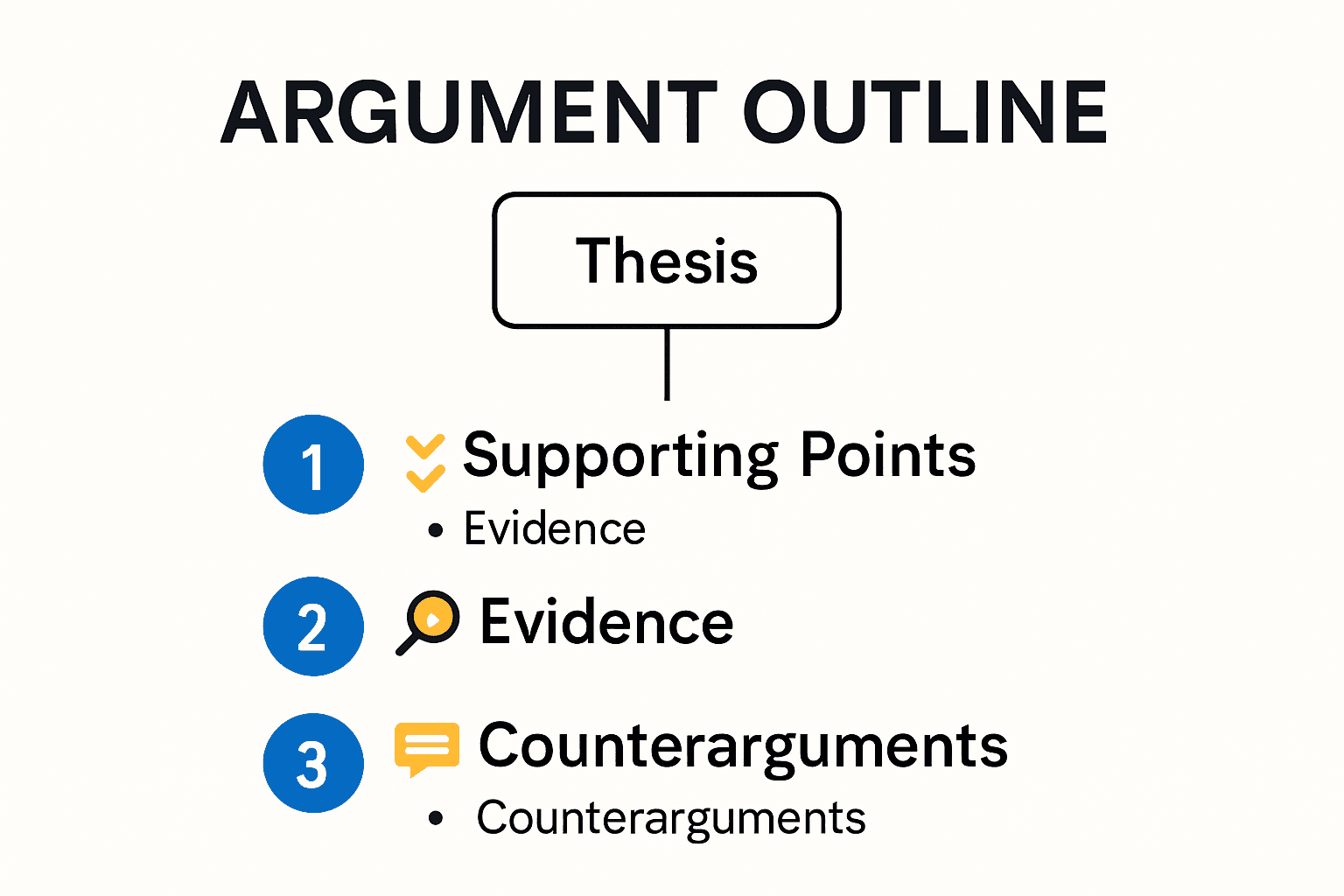Blog
Learning Materials
Argument Outline Guide 2025: Step-by-Step for Students & Academics
Updated: June 20, 2025

Building a persuasive argument is not just about lining up ideas. Academic reviewers call out one major weakness every time—unclear connections. Research shows that over 60 percent of students lose points due to vague or incomplete outlines. Here’s the surprise. The students who spend a few extra minutes mapping out their argument actually write less overall, but their ideas land with far more impact. Instead of stuffing your outline with endless notes and scattered thoughts, a focused structure can do the heavy lifting and help you stand out from the crowd.
Table of Contents
Quick Summary
| Takeaway | Explanation |
|---|---|
| Establish Clear Logic | An argument outline enhances the clarity of your ideas, creating a logical progression that strengthens your overall argument. |
| Incorporate Multiple Perspectives | Engaging with diverse viewpoints and potential counterarguments demonstrates intellectual maturity and enriches your argument. |
| Develop a Clear Thesis Statement | The thesis functions as the anchor of your argument, and it should be specific, arguable, and supportable to guide your writing effectively. |
| Remain Open to Adaptability | Treat the outline as a flexible tool that can evolve as new insights emerge from your research and writing process. |
| Avoid Common Pitfalls | Be aware of logical fallacies and weak evidence; these can undermine your argument and should be addressed during the outlining process. |

Understanding the Purpose of an Argument Outline
An argument outline serves as a critical strategic blueprint for constructing persuasive academic and professional communication. Unlike casual writing, an argument outline provides a systematic approach to developing logical, well-structured arguments that effectively communicate complex ideas and perspectives.
The Strategic Framework of Argument Outlines
At its core, an argument outline functions as a comprehensive roadmap for intellectual discourse. This strategic document does more than simply organize thoughts it creates a deliberate pathway for presenting ideas with precision and logical coherence. Researchers and students use argument outlines to transform abstract concepts into clear, compelling narratives that can withstand critical analysis.
The primary purpose of an argument outline extends beyond simple organization. It helps writers:
- Establish Clear Logic: Create a sequential progression of ideas that builds a robust intellectual argument
- Identify Potential Weaknesses: Recognize gaps in reasoning before drafting the full document
- Streamline Research: Focus research efforts on specific areas that directly support the central thesis
Components of Effective Argument Construction
Successful argument outlines require careful consideration of several critical elements. The structure must anticipate potential counterarguments, provide substantive evidence, and maintain a coherent flow of reasoning. Academic writers must approach argument development as an intellectual strategy that demands both analytical thinking and methodical presentation.
Professional researchers and students benefit from understanding that an argument outline is not a rigid template but a flexible tool for intellectual exploration. Learn more about advanced outline strategies that can transform how you approach complex writing projects.
The most effective argument outlines incorporate multiple perspectives, anticipate potential challenges, and present a nuanced understanding of the topic. This approach demonstrates intellectual maturity and creates a more compelling overall argument. By systematically mapping out ideas, writers can move beyond surface level discussions and engage in meaningful scholarly dialogue.
Whether you are a graduate student preparing a dissertation or a professional developing a complex research proposal, mastering the argument outline represents a fundamental skill in academic and professional communication. The ability to construct a clear, logical, and persuasive argument begins with a well-designed outline that strategically guides your intellectual narrative.
Understanding the purpose of an argument outline is not about following rigid rules but about developing a systematic approach to complex thinking. It transforms abstract ideas into structured, compelling narratives that can effectively communicate sophisticated intellectual concepts across various academic and professional domains.
Essential Elements of an Effective Argument Outline
Constructing an effective argument outline requires strategic planning and a systematic approach that goes beyond simple note taking. The most powerful argument outlines transform complex intellectual concepts into clear, persuasive narratives by incorporating specific essential elements that create intellectual coherence and persuasive strength.
Structural Components of Argument Precision
An argument outline demands meticulous attention to structural integrity. Each component must function as an interconnected element that supports the overall intellectual framework. The fundamental structural elements include a clear thesis statement, strategic argument segments, supporting evidence, and anticipatory counterargument analysis.
The thesis statement operates as the argumentative anchor point. It must be precise, debatable, and sufficiently narrow to allow comprehensive exploration. Academic writers should craft thesis statements that are neither overly broad nor excessively restrictive. Discover advanced outline strategies that can elevate your argumentative approach.

Supporting evidence represents the critical muscle of an argument outline. Effective evidence must be:
- Credible: Sourced from reputable academic or professional references
- Relevant: Directly connected to the central thesis
- Diverse: Incorporating multiple perspectives and research approaches
Analytical Depth and Intellectual Rigor
Beyond basic structural requirements, an exceptional argument outline demonstrates analytical depth. This means moving beyond surface level descriptions and engaging in sophisticated intellectual exploration. Successful outlines integrate critical thinking by systematically addressing potential counterarguments and demonstrating nuanced understanding of complex topics.
The most sophisticated argument outlines anticipate potential challenges to the central argument. This proactive approach involves identifying potential weaknesses, understanding alternative perspectives, and developing robust responses. Such intellectual preparation transforms an ordinary outline into a comprehensive argumentative strategy.
Researchers and academic writers must approach argument development as an intellectual chess match. Each section of the outline should be strategically positioned to build a compelling narrative that guides readers through a logical progression of ideas. The goal is not just to present information but to create an engaging intellectual journey that convinces and enlightens.
Argumentative writing demands more than mechanical precision it requires creative intellectual construction. An effective argument outline balances structured methodology with creative thinking. Writers must remain flexible enough to adapt their outline as research reveals new insights while maintaining the core argumentative integrity.
Mastering the essential elements of an argument outline represents a fundamental skill in academic and professional communication. It transforms abstract concepts into structured, compelling narratives that can effectively communicate sophisticated intellectual perspectives across various disciplines and professional domains.
How to Structure Your Argument Step by Step
Creating a compelling argument requires a methodical approach that transforms complex ideas into a clear, persuasive narrative. The step-by-step process of structuring an argument is not about following rigid rules but about developing a strategic intellectual framework that guides readers through your reasoning.
Developing Your Central Argument
The first critical step in argument construction involves identifying and refining your central thesis. This foundational element serves as the intellectual compass for your entire document. Begin by asking yourself critical questions: What is the core idea you want to communicate? What specific perspective are you presenting? What evidence can substantiate your claim?
Research plays a crucial role in thesis development. Explore comprehensive outline strategies that can help you transform initial concepts into robust arguments. Your thesis should be:
- Specific: Narrow enough to be thoroughly explored
- Arguable: Presenting a perspective that invites intellectual discussion
- Supportable: Backed by credible evidence and research
Constructing a Logical Argument Progression
Once you have established your central thesis, the next step involves creating a logical progression of ideas. Think of your argument as an intellectual journey where each section builds upon the previous one. This means carefully mapping out how your supporting points will connect and reinforce your central thesis.
Effective argument structure typically follows a strategic sequence:
- Introduction of the central thesis
- Presentation of supporting evidence
- Analysis of how evidence reinforces the main argument
- Anticipation and address of potential counterarguments
- Conclusive synthesis of key points
Each section of your argument should function like a puzzle piece that fits precisely into the larger intellectual framework. This requires careful consideration of how ideas connect and build upon one another. Academic writers must approach this process with both analytical precision and creative thinking.
The most sophisticated arguments demonstrate intellectual flexibility. While maintaining a clear structural approach, writers must remain open to nuanced interpretations and complex perspectives. Your argument outline should provide a roadmap that guides readers through your reasoning while leaving room for sophisticated intellectual exploration.
Mastering the step-by-step process of argument structure represents a fundamental skill in academic and professional communication. It transforms abstract concepts into structured, compelling narratives that can effectively communicate sophisticated intellectual perspectives across various disciplines and professional domains.
Pro Tips and Common Mistakes to Avoid
Argument outlines represent a sophisticated intellectual tool that demands precision, creativity, and strategic thinking. While many students and researchers understand the basic principles, mastering the nuanced art of argument construction requires awareness of critical strategies and potential pitfalls.
Strategic Planning and Intellectual Preparation
Successful argument development begins with comprehensive intellectual preparation. Professional academic writers recognize that an outstanding argument outline goes far beyond mechanical structure it represents a dynamic intellectual framework. The most common mistake is treating the outline as a rigid template rather than a flexible intellectual roadmap.
Key strategic considerations include:
- Research Depth: Conduct thorough preliminary research before finalizing your outline
- Perspective Diversity: Incorporate multiple viewpoints and potential counterarguments
- Adaptability: Remain open to modifying your outline as new insights emerge
One critical mistake many writers make is prematurely committing to a single perspective. Explore advanced research techniques that can help you develop more nuanced and comprehensive arguments.
Avoiding Common Argumentative Pitfalls
Effective argument construction requires acute awareness of potential intellectual traps. The most frequent mistakes include logical fallacies, insufficient evidence, and overly broad claims. Academic writers must develop a critical eye that can identify and address these potential weaknesses before they undermine the overall argument.
Common pitfalls to avoid:
- Confirmation bias in research selection
- Oversimplifying complex topics
- Failing to anticipate potential counterarguments
- Using weak or irrelevant supporting evidence
- Neglecting to provide clear logical connections between ideas
Professional researchers approach argument development as an intellectual chess match. Each element of the outline must be strategically positioned to build a compelling narrative. This requires moving beyond surface level descriptions and engaging in sophisticated critical thinking.
The most sophisticated argument outlines demonstrate intellectual humility. This means acknowledging the limitations of your perspective while still presenting a clear and compelling case. Writers must balance confidence with openness to alternative interpretations.
Mastering the art of argument outline construction is not about following rigid rules but about developing a nuanced approach to intellectual communication. It requires continuous learning, critical self reflection, and a commitment to intellectual growth. By understanding common mistakes and implementing strategic approaches, you can transform your argument outlines from simple documents into powerful tools of scholarly communication.
Ultimately, an exceptional argument outline is more than a structural document it is a testament to your intellectual rigor, critical thinking skills, and ability to communicate complex ideas with clarity and precision.
Frequently Asked Questions
What is the purpose of an argument outline?
An argument outline serves as a strategic blueprint for constructing persuasive academic communication, helping to create clear logic, identify weaknesses, and streamline research.
How do I develop a strong thesis statement for my argument outline?
To develop a strong thesis statement, ensure it is specific, arguable, and supportable. It should clearly communicate your main idea while inviting discussion and analysis.
What are common mistakes to avoid when creating an argument outline?
Common mistakes include committing to a single perspective too early, using weak evidence, failing to anticipate counterarguments, and neglecting clear logical connections between ideas.
How can I structure my argument step by step?
Structure your argument by first developing a clear thesis, then creating a logical progression of supporting ideas, addressing counterarguments, and concluding with a synthesis of your key points.
Transform Outline Clarity into Academic Excellence with Samwell.ai
Struggling with vague outlines or missing logical flow in your arguments? This guide spotlighted a common pain point: students often lose points because their argument structure lacks precision and clear connections. It is frustrating to put in effort and still risk losing marks to disorganization or unclear logic. You want your central thesis to stand out, your evidence to shine, and your outline to withstand even the toughest academic scrutiny. But the path from rough notes to a polished outline can feel overwhelming.

Why not turn these obstacles into stepping stones for success? With Samwell.ai, you gain access to powerful tools like 'Guided Essays' and the innovative 'Power Editor' that help you create structured, persuasive outlines from the start. Let our Semihuman.ai technology guide you in producing original, credible arguments that meet proper citation standards every time. Join over a million students already crafting exceptional work that is both effective and authentic. Visit Samwell.ai today and make your next argument outline your strongest yet.
Recommended Articles
Generate essays with Samwell.ai
Whether you’re a publisher, professor, journalist, or student, let us tailor a plan just for you.Most Read Articles

Your Guide to Help Writing a Essay Successfully
Expert tips for help writing a essay - from crafting a thesis to structuring your essay effectively.

How to Write Critical Thinking Essay: Expert Tips
Expert tips for writing a critical thinking essay. Learn how to structure, choose topics, and use evidence effectively.'

How to Write a Good Hook: A Step-by-Step Guide
Master the art of crafting a good hook with our guide. Create compelling openers for a memorable first impression.

